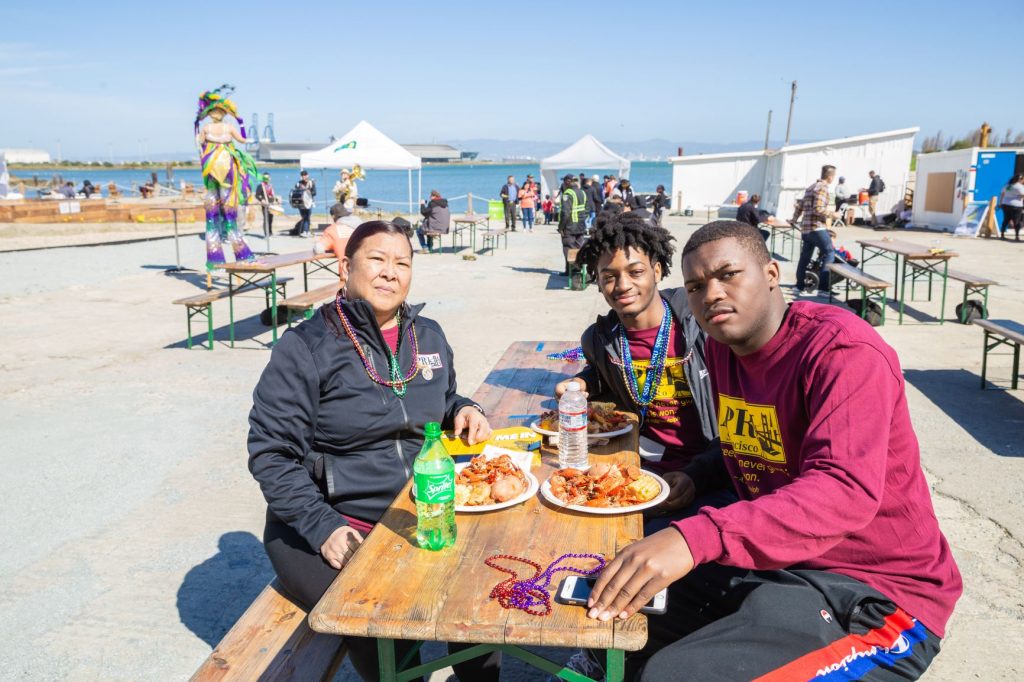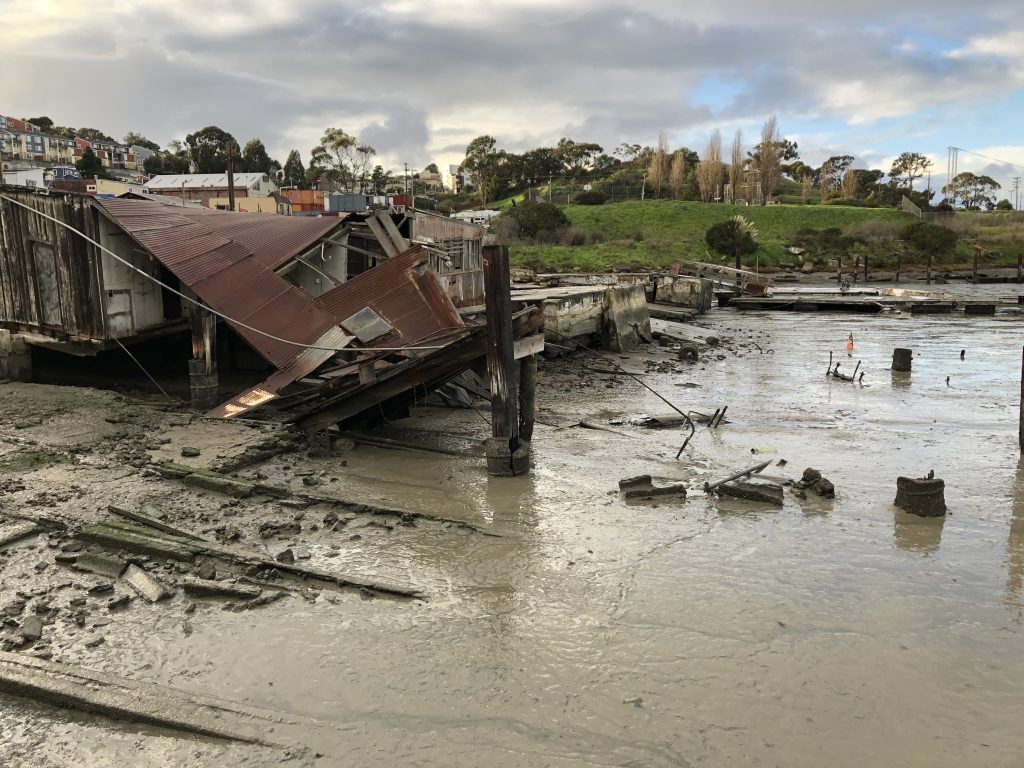
I live just a couple miles from Berkeley Aquatic Park, but it took a shelter-in-place order to get me to go back there after a 20-year hiatus. I had visited the park a couple years after I moved to the Bay Area and found it deserted and a bit gloomy. This time, it was vibrant and full of life, from the bright yellow gumplants blooming along the shoreline to the great blue heron feeding in the shallows and shiny-black cormorants diving deep underwater, then returning to the surface to dry their wings in the sun.
And the people! There were kids playing on the playground, cyclists zipping along the Bay Trail, and frisbee golfers politely asking me to move out of the way so they could continue with their game. Along the shore were theater and dance spaces, a bike and boat repair and rental shop, and a place where cyclists with disabilities could get access to adaptive equipment. The lagoon was created by humans, a depression scooped out of the land when the Bayshore Highway was constructed in the 1930s, but that didn’t stop it from hosting a range of shorebirds and waterfowl and people of all ages and backgrounds.
The COVID crisis has forced many of us to rethink what it means to have access to parks and trails close to home. Just as the murder of George Floyd and the Black Lives Matter protests that followed led many people to wake up to the injustices of our policing and criminal justice systems, the orders to shelter in place forced a deeper reckoning in the conservation community with the inequities of access to nature and recreational spots in the Bay Area.
Many of the privileged people who led the conservation movement for generations tended to value faraway, pristine cathedrals of nature, such as Yosemite and Lake Tahoe. Over time, there has been a dawning recognition that our movement needs to be more inclusive and connect people to nature close to home. In 1998, I joined Friends of Five Creeks, a group of volunteers working to clean up local creeks in Berkeley and El Cerrito. We removed trash and invasive plants, planted natives, and advocated for “daylighting” creeks that had been forced underground into culverts to control flooding. For us and hundreds of other members of “Friends” groups around the Bay Area, nature was here, not somewhere you had to drive at least a couple hours to experience.
Within the San Francisco Bay restoration community, there has been a similar shift. While we still focus on restoring large areas of tidal marsh habitat in former salt ponds and hay fields of the North and South Bay to benefit the endangered Ridgway’s rail and salt marsh harvest mouse, we now recognize the importance of creating spaces along the shoreline where people, especially people from economically disadvantaged communities, can learn about and participate in nature conservation. As sea level rises, we also recognize the importance of engaging leaders from these communities, including those fighting environmental injustice and gentrification, in nature-based shoreline adaptation planning.
Measure AA, a $12 annual parcel tax that funds projects administered by the San Francisco Bay Restoration Authority, specifically calls for prioritizing projects that benefit economically disadvantaged communities. Over the past two years, the Authority has grappled with what this means. Some benefits are relatively straightforward, such as providing trails, flood protection, and green jobs to residents of nearby communities. But other benefits are more subtle, such as creating opportunities for leadership development in shoreline restoration planning, and supporting efforts to prevent “green gentrification,” the process by which local residents are priced out of their communities as they become cleaner, greener and more desirable to wealthier people.
Also, it is not enough for a restoration-focused agency or organization to decide which benefits to provide — the community needs to weigh in. And for community engagement to be meaningful, project managers must be open to making changes that reflect what community members want. Several of the Authority’s current projects, such as the North Richmond Shoreline Living Levee Project, take steps in the right direction. (See following stories for more examples.) In addition, the Authority recently launched a Community Grants Program to provide a simplified pathway to grants for community-based organizations in economically disadvantaged communities.

The Black Lives Matter movement is also teaching us that the conservation community has much work to do to make outdoor spaces more welcoming to Black, Indigenous, and other people of color (BIPOC). National attention was drawn to this pervasive problem through the high-profile incidents suffered by Christian Cooper, who was “birding while Black” in New York City’s Central Park, and a group of friends who were “BBQing while Black” at Lake Merritt. Both cases involved white people calling the police on Black people doing harmless things in parks. I thoroughly condemn this type of dangerous harassment, as well as more subtle snubs of Black people in natural places. To combat racism and promote diversity, Black nature lovers have launched #BlackInNature, #BlackBirdersWeek and @BlackAFinSTEM. Just a few of the groups taking action to support BIPOC in the outdoors include Outdoor Afro, Brown Girl Surf, and Latino Outdoors — check them out!
On a recent Sunday afternoon at Point Pinole Regional Shoreline, I noticed that the park was full of a diverse mix of people enjoying the outdoors in their own ways, whether hiking, jogging, birding, picnicking, or just sitting and chatting while enjoying the inspiring vistas of the Bay. As we continue to spend much of our time in isolation, there’s a special joy that comes from connecting with people and nature along the Bay. And that’s something everyone in the region should be able to share.
Three Measure AA Projects that Benefit Economically Disadvantaged Communities
The Oakland Shoreline Leadership Academy aims to empower community leaders to engage in shoreline restoration planning. Led by the West Oakland Environmental Indicators Project, a community-based nonprofit organization with a long history of fighting for environmental justice, the project will provide a six-month training program in shoreline environmental issues. It will also create opportunities to build partnerships with shoreline landowners such as the Port of Oakland and East Bay Regional Park District. Participants will engage in planning processes for ongoing shoreline restoration and public-access projects as well as develop ideas for future projects.
Heron’s Head Park in San Francisco is a 22-acre open space and restored wildlife habitat that attracts more than 100 bird species every year. The park and its EcoCenter are also used for education and recreation by thousands of birdwatchers, hikers, students, teachers, and other visitors. And the Heron’s Head Park Shoreline Resilience Project will provide even more benefits to both people and wildlife. With funding from the Authority, the Port of San Francisco has partnered with the community-based nonprofit Literacy for Environmental Justice (LEJ) to recruit young residents of the Bayview-Hunters Point community to be Eco-Apprentices. These apprentices will be trained by LEJ and by researchers from San Francisco State University in bay ecology, invasive weed control, native plant propagation and outplantings, and project monitoring.
The 900 Innes Remediation Project provides another model of community empowerment through shoreline restoration. A polluted former shipbuilding and boat repair site in the Bayview-Hunters Point neighborhood will be finally cleaned, then replaced with a new waterfront park featuring miles of winding trails, acres of restored tidal landscape, and an abundance of recreation opportunities. The neighborhood, one of the last remaining communities in San Francisco with a significant Black population, has a history of environmental contamination and neglect. More recently, it has been referred to as “ground zero” for gentrification. To ensure that the new park will serve the best interests of this community, the San Francisco Recreation and Park Department has been working with local residents and non-profit organizations to develop the project design in an equitable way.

After San Francisco Rec and Park acquired the 900 Innes boatyard property in 2014, the India Basin Waterfront Task Force, comprising Bayview-Hunters Point community leaders, landowners, and nonprofit parks partners, began working with the broader community to gather input. Today the department continues to collect feedback on the park design, including arts enrichment, boatyard park design and elements, and, most recently, the playground design, to ensure that the designs remain relevant and reflective of the neighborhood’s priorities.
In 2018, recognizing the potential for this major public park investment to contribute to displacement, the department and its partners sought to create opportunities to allow existing communities to thrive in place, especially current Black residents. The project team initiated a process to create an Equitable Development Plan (EDP). The EDP Leadership Committee is composed of a coalition of Bayview-Hunters Point leaders with expertise in workforce training, business development, youth development, public arts, and local history. Acting as local consultants with deep community ties across Bayview-Hunters Point, the Leadership Committee continues to help plan ongoing engagement events and prepare for the community’s future use of the park after remediation is complete.
The first phase of the project will address decades of pollution and environmental degradation in an area marred by heavy industrial use. Specially trained crews will clean up contamination, debris, and abandoned structures on land, along the shoreline, and in shallow sediments. At least two feet of soil will be removed across the site — then replaced with new soil to support the future park design. [Reporting support Nate Seltenrich]
Top Photo: Jessica Davenport at Berkeley Aquatic Park.
Related Prior Estuary Stories